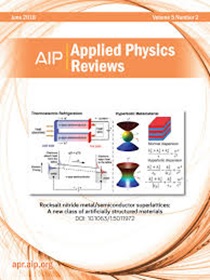Lithium niobate tuning fork-enhanced photoacoustic spectroscopy and light-induced thermoelastic spectroscopy
IF 11.6
1区 物理与天体物理
Q1 PHYSICS, APPLIED
引用次数: 0
Abstract
In this paper, the performance of two self-designed lithium niobate tuning forks (LiNTF), round-head and tapered LiNTFs, was systematically explored in lithium niobate-enhanced photoacoustic spectroscopy (LiNPAS) and light-induced thermoelastic spectroscopy (LITES) sensors. Finite element analysis results revealed that the stress and surface charge density of the LiNTFs were higher than those of the standard quartz tuning fork (QTF), owing to the high piezoelectric coefficient and electromechanical coupling coefficient of the LiNbO3. The sensing performance of the two LiNTFs was experimentally evaluated, and acetylene (C2H2) was used as the test gas for performance validation. In the C2H2–LiNPAS system, the 2f signal peak values of the round-head LiNTF and the tapered LiNTF were 3.47 times and 4.29 times higher than those of the standard QTF, respectively. When the average time reached 1000 s, the minimum detection limits (MDLs) of the sensor based on round-head LiNTF and the tapered LiNTF were 723 and 450 ppb, respectively. In the C2H2–LITES system, the 2f signal peak values of the round-head LiNTF and the tapered LiNTF were found to be 3.79 times and 5.13 times higher than that of the standard QTF. The MDLs of the LITES sensor based on the round-head LiNTF and the tapered LiNTF were determined to be 101 and 52 ppb, respectively.铌酸锂音叉增强光声光谱和光致热弹性光谱
本文在铌酸锂增强光声光谱(LiNPAS)和光致热弹性光谱(LITES)传感器中系统地研究了两种自行设计的圆头和锥形铌酸锂音叉(LiNTF)的性能。有限元分析结果表明,由于LiNbO3具有较高的压电系数和机电耦合系数,其应力和表面电荷密度高于标准石英音叉(QTF)。实验评估了两种lintf的传感性能,并以乙炔(C2H2)作为测试气体进行了性能验证。在C2H2-LiNPAS体系中,圆头LiNTF和锥形LiNTF的2f信号峰值分别是标准QTF的3.47倍和4.29倍。当平均时间达到1000 s时,圆头LiNTF和锥形LiNTF传感器的最小检测限(MDLs)分别为723和450 ppb。在C2H2-LITES系统中,圆头LiNTF和锥形LiNTF的2f信号峰值分别是标准QTF的3.79倍和5.13倍。基于圆头LiNTF和锥形LiNTF的LITES传感器的MDLs分别为101和52 ppb。
本文章由计算机程序翻译,如有差异,请以英文原文为准。
求助全文
约1分钟内获得全文
求助全文
来源期刊

Applied physics reviews
PHYSICS, APPLIED-
CiteScore
22.50
自引率
2.00%
发文量
113
审稿时长
2 months
期刊介绍:
Applied Physics Reviews (APR) is a journal featuring articles on critical topics in experimental or theoretical research in applied physics and applications of physics to other scientific and engineering branches. The publication includes two main types of articles:
Original Research: These articles report on high-quality, novel research studies that are of significant interest to the applied physics community.
Reviews: Review articles in APR can either be authoritative and comprehensive assessments of established areas of applied physics or short, timely reviews of recent advances in established fields or emerging areas of applied physics.
 求助内容:
求助内容: 应助结果提醒方式:
应助结果提醒方式:


